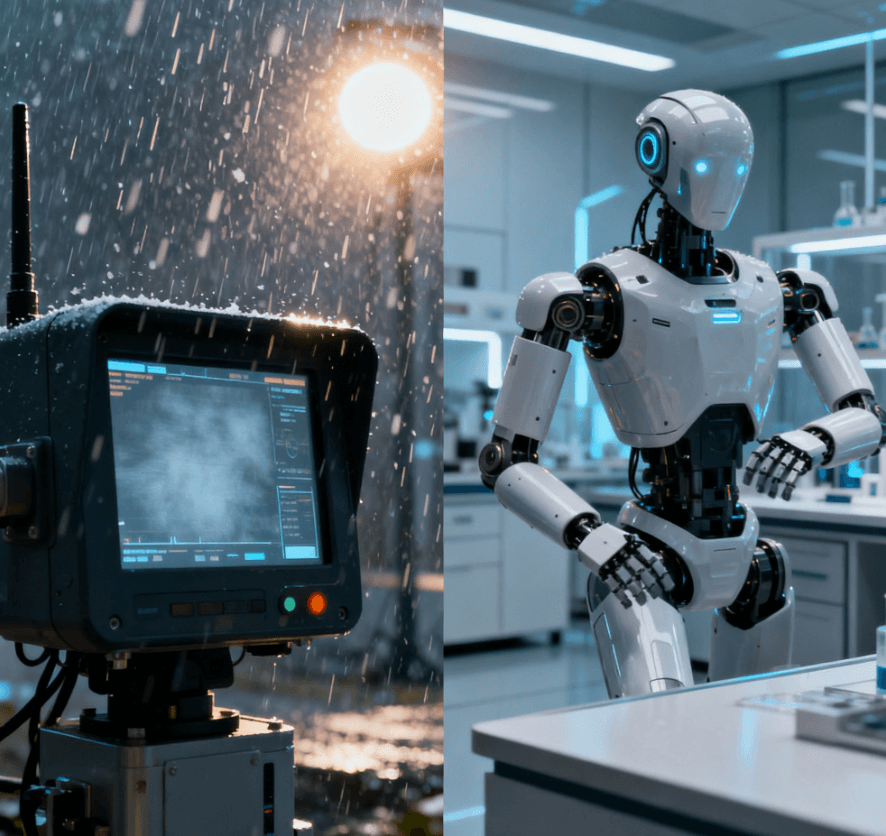You've observed a crucial paradox in modern AI: We possess powerful AI models capable of writing complex papers and creating art, yet getting a robot to smoothly complete tasks like "folding laundry" or "safely navigating a cluttered warehouse" remains an enormous challenge.
As you rightly identify, Robotics Training Data is rapidly becoming the foremost bottleneck for achieving Artificial General Intelligence (AGI). Unlike Large Language Models (LLMs) which feast on vast universes of text data, robots require immense volumes of high-precision, highly robust, multi-modal physical interaction data.
The current scarcity of such data—a genuine lack of a global, scalable "Robotics CommonCrawl"—is the root cause of poor generalization and reliability in modern robot models. Overcoming this requires addressing two fundamental challenges:
-
Environmental Robustness: Sensor data must be stable and reliable regardless of lighting or weather conditions.
-
Dynamic Perception: Data must precisely capture an object's velocity and motion state.
Based on these critical requirements, mmWave Radar (Millimeter-wave Radar) technology is quickly emerging as the essential core solution for breaking the robotics data bottleneck and constructing the next-generation training data infrastructure.
🚨 Traditional Sensors: The Fatal Flaw in Robot Model Generalization
As robots transition from controlled laboratories to unstructured, real-world environments, reliance solely on traditional visual and depth sensors introduces critical data defects:
These data vulnerabilities inevitably lead to robot models "forgetting" or "crashing" when faced with novel environmental changes. Therefore, the market urgently demands a sensor that provides a stable, multi-dimensional, and cost-effective data stream to fill these critical gaps.
📡 mmWave Radar: The Multi-Dimensional Data Anchor and Core Advantage
mmWave Radar technology, exemplified by solutions offered by companies like Linpowave, provides unprecedented stability and richness to robotics training data through its unique physical properties and data output dimensions.
1. All-Weather Data Collection: Ensuring Training Data Robustness
mmWave Radar operates in high-frequency bands (such as 76-81 GHz), where the properties of its electromagnetic waves grant it superior environmental penetration power—its single greatest data advantage:
-
Light Independence: Radar operation is completely independent of visible light. Whether in total darkness, under strong backlight, or in the complex light transition zones between indoors and outdoors, radar provides continuous and stable range and velocity data.
-
Adverse Environment Immunity: Radar signals effectively penetrate non-metallic materials, including rain, fog, snow, dust, and smoke. This is crucial in logistics, mining, or outdoor inspection scenarios.
-
Data Value: This capability resolves the Environmental Bias inherent in robotics training data. It ensures that datasets cover all extreme conditions, fundamentally boosting the model's reliability and generalization—a necessity for training operational systems.
2. Native Velocity Information: Precise Dynamic Labeling for Safety
Robots require a deep understanding of an object's dynamic state. mmWave Radar utilizes the Doppler Effect to precisely measure a target's radial velocity, providing dynamic information unmatched by other sensors:
-
Real-Time Motion Tracking: Radar directly outputs the highest precision, most reliable velocity and acceleration data. This can be used as Kinematic Labels within the training data, allowing AI models to accurately predict motion trajectories. This is the cornerstone of achieving Functional Safety (FS).
-
Core of Functional Safety: In industrial and medical settings, accurate velocity measurement is the baseline safety requirement for collision avoidance and kinetic energy control. Training data with accurate velocity labels enables models to learn safe deceleration, stopping, and dynamic maneuvering.
3. 4D Radar Technology: Elevating Spatial Perception Data
Advancements in the field have popularized 4D mmWave Radar. It adds the dimension of Elevation to the traditional dimensions of range, azimuth, and velocity:
-
Data Completeness: 4D data overcomes the traditional radar's weakness in vertical resolution. This allows robot models to accurately perceive and differentiate obstacles in three-dimensional space—for example, distinguishing between a small object on the floor and an object suspended overhead.
-
High-End Applications: This high-dimensional data provides critical, high-quality input for scenarios such as precise altitude measurement for Unmanned Aerial Vehicles (UAVs), intricate shelving avoidance for Autonomous Guided Vehicles (AGVs), and environmental modeling for humanoid robots. You can explore how Linpowave utilizes 4D mmWave Radar for applications in drones and smart vehicles: https://linpowave.com/
4. Micro-Motion Recognition: Data for Collaboration and Intent
Advanced mmWave Radar can even capture minute vibrations or movements—the Micro-Doppler Effect.
-
Behavior Classification: Unique micro-Doppler signatures are generated by human behaviors like breathing, walking gait, or subtle hand gestures. These signatures can be included in the training data, enabling robot models to perform high-level behavior classification and intent prediction.
-
Value Extension: In Human-Robot Collaboration (HRI) environments, models trained on this data can infer human intent and status, ensuring the robot reacts safely and naturally when operating in close proximity, thereby pushing the intelligent upper limit of the robot.
융 Sensor Fusion: The Architecture for Scalable Data
While mmWave Radar offers exceptional robustness, its resolution is inherently lower than that of LiDAR. Therefore, the ultimate solution to the robotics data bottleneck is Multi-Modal Sensor Fusion, where radar serves as the Data Reliability Anchor within the system.
Integrating mmWave Radar data with Vision and LiDAR data achieves a qualitative leap in the robotics training data infrastructure:
1. Drastically Reduced Data Labeling Costs
The most expensive component of robotics data collection is manual labeling.
-
Automated Label Generation: The precise, real-time range and velocity data output by the radar can be utilized as the "Ground Truth" for motion. AI algorithms can leverage these reliable radar labels to automatically calibrate and annotate the corresponding dynamic objects in video or point cloud data, drastically cutting down on time-consuming manual labeling.
-
Unified Timeline: Radar provides a stable motion timeline for multi-sensor data, ensuring all sensor feeds are highly synchronized and calibrated, thereby improving the temporal accuracy of the training dataset.
2. Enabling Hardware Cost Reduction and Scalable Collection
Compared to high-end LiDAR, mmWave Radar is characterized by its low cost, compact size, and ease of integration. This is paramount for scalable data collection.
-
Low cost means a greater number of robots and collection platforms can be deployed, enabling the acquisition of massive, diverse training data with unprecedented speed and variety.
-
This scalability is the physical foundation for building the future "Internet of Data" for robotics.
💡 Conclusion and Outlook: The Future of Robotics Training Data
Your focus on the robotics training data bottleneck is spot-on; it represents the largest technical and commercial opportunity today. The success of general-purpose robot AI hinges on the ability to construct a training dataset that is massive, robust, and multi-dimensional.
mmWave Radar is the core driving force behind this transformation. By providing all-weather robustness, precise dynamic information, and cost efficiency, it solves the two greatest deficits in robotics datasets: environmental uncertainty and missing motion kinetics.
The future trend is undoubtedly deep sensor fusion: leveraging radar data to automate labeling, validate, and enhance visual and depth data, ultimately building robot models that can truly understand and cope with the complexities of the physical world.
📚 Further Reading and Authoritative Resources
-
Deep Dive into Functional Safety: Refer to the ISO 26262 standard requirements for functional safety levels in autonomous and robotic systems: https://www.iso.org/standard/68383.html
-
Multi-Modal Data Fusion: Explore the latest advancements in sensor fusion for autonomous navigation: https://ieeexplore.ieee.org/abstract/document/9253457
-
Robotics Perception and Learning: Learn more about the foundations of robot perception, decision-making, and control on our site: /blog/robotics-perception-learning-foundations
-
Linpowave Product Portfolio: Explore Linpowave's specialized 4D mmWave Radar solutions across industries like traffic, drones, and healthcare: https://linpowave.com/
❓ Frequently Asked Questions (FAQ)
Q1: Can mmWave Radar replace cameras or LiDAR for collecting robotics training data?
A: No. mmWave Radar's strengths are velocity measurement and environmental robustness, but it cannot match the spatial resolution and object detail recognition of cameras and LiDAR. Future robotics training data will rely on sensor fusion: Radar provides the highly reliable motion and range foundation, while cameras and LiDAR provide the high-resolution geometric and semantic details.
Q2: What is the biggest advantage of 4D mmWave Radar over traditional radar for data collection?
A: The biggest advantage is the addition of Elevation information. This allows the radar data to fully map three-dimensional space, solving the traditional issue of poor vertical resolution. This provides crucial height accuracy for the training data, which is essential for vertical obstacle avoidance in UAVs, humanoid robots, and warehouse AGVs. You can review Linpowave's 4D Radar technology details here: /blog/4d-mmwave-radar-industrial-applications
Q3: How does mmWave Radar help lower the cost of labeling robotics training data?
A: mmWave Radar helps by automatically generating high-precision motion labels. The radar's direct measurement of real-time velocity and range can serve as "Ground Truth" to automatically calibrate and annotate the dynamic objects in corresponding video or point cloud data, drastically reducing the labor and cost of manual labeling.
Q4: What special role does mmWave Radar data play in Human-Robot Collaboration (HRI) training?
A: The radar's micro-motion recognition capability is crucial. It can capture subtle human movements, such as breathing, minor gestures, and motion patterns. This data trains robot models to predict human intent and state, ensuring the robot reacts safely and promptly when working in close proximity, thus preventing accidents.
Considering industrial logistics and medical assistance—fields demanding extreme safety and robustness—which of the two radar capabilities, accurate velocity measurement or micro-motion recognition, is more decisive for maximizing the value of the training data?



